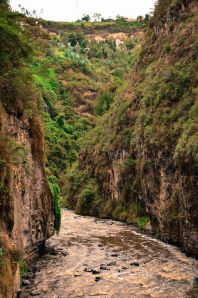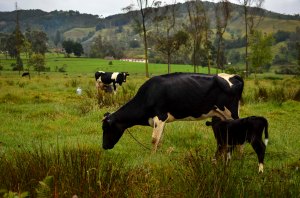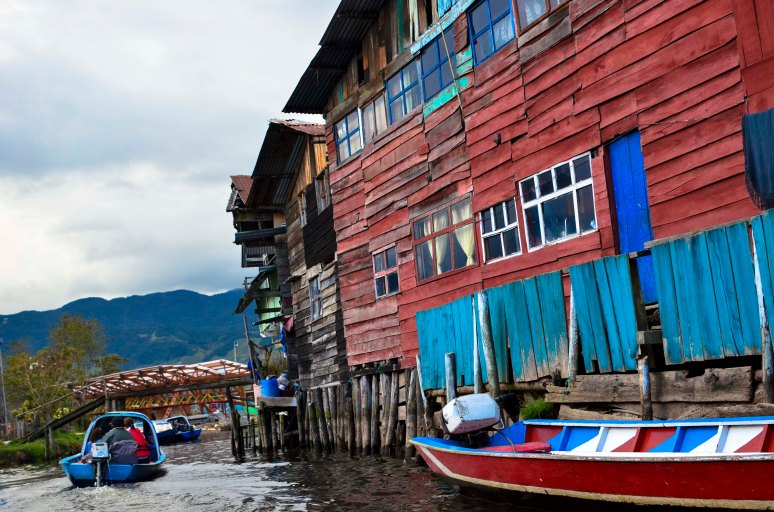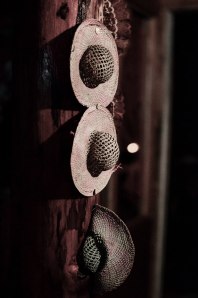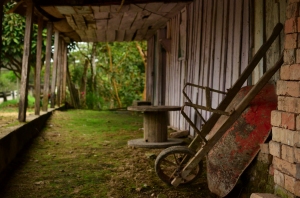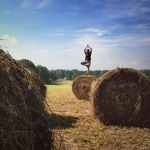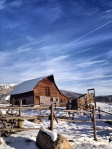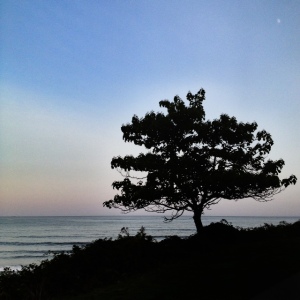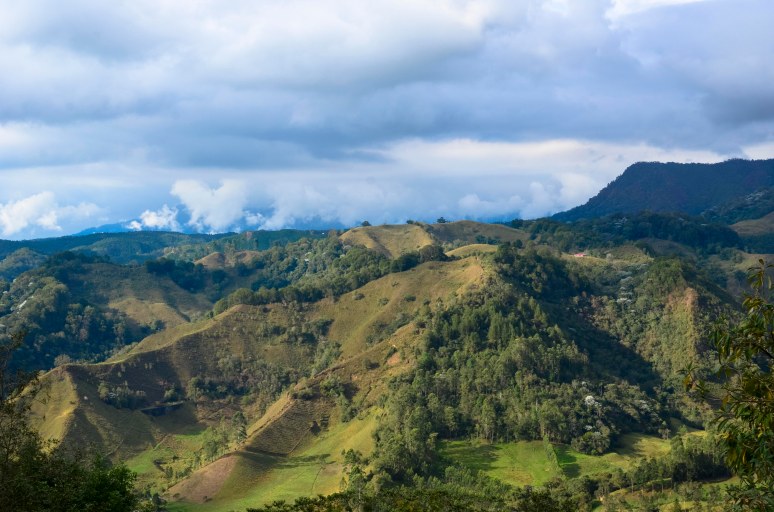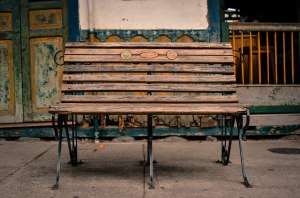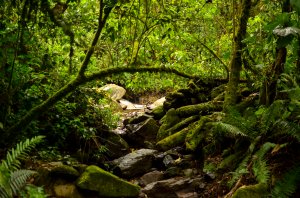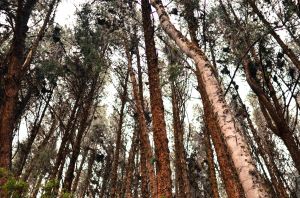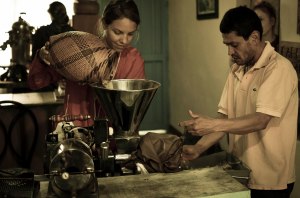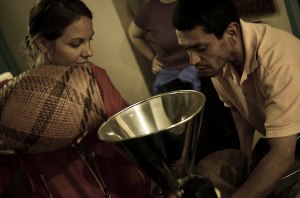Ipiales and the Santuario de Las Lajas. Adios Colombia!
I can’t help but remember some sadness when we traveling south from Laguna De La Cocha and approaching the final destination of our journey in Colombia. A worn in white sedan was our collectivo ride from the lakeside village to Ipiales, which was a border town between Colombia and Ecuador. The mood was somber in my head, and felt like I was watching the last grains of sand disappear from an hourglass that I had secretly hoped would be full forever. I didn’t want to accept the fact that our adventure in this country was almost up. Perhaps it was because the previous two and half months felt like a full years worth of memories, and in my heart I knew Colombia had a lot more to give. This is one of the bittersweet aspects of travel when facing the inevitable departure that looms ahead in plain sight. It makes your heart rush in a way that you can’t enjoy but can’t despise either. You hate leaving it behind, but you love the excuse to come back for more. In a way it’s like you are closing a door but deliberately leaving it unlocked for another moment in time.
Ipiales itself was not something worth writing about from the little we saw. It was a border town by nature, and did not have much for outsiders to see in the town itself other than transfer modes of transportation towards points unknown. I’ve heard that some towns accessible in the area have some great views and abundant natural resources, but we were not entertaining the idea of hunting for treasure at the time. The main attraction to this town was the ethereal basilica of Las Lajas, and that was the only thing on our agenda. We caught a cab from the large bus station hub and within minutes we were heading away from the border along quiet windy roads descending down the plateau and into a valley. Small houses and little plots of cultivated land occupied this sleepy area as our road kept weaving down into lower lands. Eventually, a small gorge with buildings on either side indicated that we were getting into the little village surrounding the basilica. Our collectivo driver dropped us off, and indicated where lodging could be found. We stumbled into one of the few hotels that appeared to be open during this slow time of year, which also happened to be called “Hotel Dan”. The universe was too obvious at times, and we checked into our accommodations immediately. It was getting a dark at that time, so we decided to stroll through town and take a look at the church we’ve been hearing about.
The town we explored almost felt abandoned. There were small shops with their doors open and lights on, but appeared to be catering to the locals that lived there year round. Small groups of children were playing soccer on beautiful cobblestone walking streets, with the faint sound of Latin music playing out of open windows. The rows of buildings that lined the streets all appeared to be targeting large groups of tourist crowds, which were noticeably missing, thus almost every single one was closed and didn’t look like they were going to open until their customer base returned. The buildings were typical of the Spanish Colonial style architecture, with some large church like structures that appeared to be weathering away without much indication of plans for restoration. My heart pined to explore past it’s huge, old wooden doors to see what kind of history was held within it’s arched concrete walls. A path meandered down into the gorge where the church was located, and we soon found ourselves staring in awe at the sight in front of us.
Santuario de Las Lajas is an architectural masterpiece that almost seems like it’s out of place in a random valley of Colombia, yet it’s presence is cemented in history in the green gorge that it’s massive arches span across. Legend has it that in the 1700’s, a mother named Maria and her deaf-mute daughter Rosa were seeking shelter in an epic thunderstorm in between the large flat rocks, or “Lajas”. During the storm, her daughter Rosa noticed an image on one of the rocks that appeared to be the Virgin Mary, and she spoke to her mother to point it out, which is the first recorded miracle associated with this location. Since then, churches have been built around the rock with the image, and believers long and far travel to Las Lajas to ask for a miracle of their own. Donations from fellow worshipers and families looking for miracles have been funding the multiple versions of the churches, and the current Gothic Revival style showpiece was constructed slowly between 1916-1949 in the same manner. The path leading up to and around the church was covered in plaques of miracles that families were hoping that would come true. There must have been thousands cemented into the earth with countless families asking for help or thanking for the miracles that were performed. I can only imagine the great lengths these families would travel to this site to ask for help in their trying times, making the pilgrimage from countries that were days away by bus.
The church was absolutely phenomenal in both grandeur and it’s physical setting. It rises about 100 meters above the fast moving muddy waters of the Guaitara River below, and has an arched bridge that spans the entire width of the canyon. The church’s color scheme was probably what made it so attractive to my eyes, rising from the green valley in earthy grey tones and stark white highlights. It was one of those places where your inner voice was instantly hushed by the presence of this sacred site. Soaring stain glass windows depicting scenes from the bible were protected by ornate iron gates. Angels were on every pillar of the bridge spanning the gorge, each of them playing a musical instrument. I was particularly drawn to the one playing the saxophone for some reason. The large wooden doors to the church opened with ease and unveiled the sacred space hidden within. Gold leafed arches, cavernous ceilings, cream colored walls, and beautiful chandeliers were a feast for the eyes. The alter was positioned directly in front of the very rock that the Virgin Mary’s image was first seen by the young Rosa back in the 1700’s. With a bit of imagination, it was possible to see the shape of the sacred icon. We explored the church while the sun set behind the hills and were eventually notified that the church was getting locked up. We left, leaving the rest of the exploring for the morning and sought some hot food wherever we could find it.
In the morning, we woke up extra early to catch the morning light on the church and the valley. We wandered over the arched bridge and up a path to get a glimpse at the church in it’s setting from the top of the gorge. The path went past some small dwellings planted on the top of the hillside, afforded views of a tall waterfall, and eventually up to a great lookout point where we were the only ones soaking in the stunning view. There was a small local boy who appeared above us and would get our attention by throwing flowers, then disappear when we would try an interact. I could only imagine what growing up in an isolated town like this could be like for him or any kid in this area. We walked back down to the church and found a different path around the opposite side that led us up into the hidden parts of the village. There, we encountered older women, presumably llama farmers, tending their animals and doing chores. One lady had about 6 kittens outside of her house, and she spoke with us briefly asking us if we wanted a cat. It seemed to be an older crowd in this village, and I’m guessing that the younger generation left for other opportunities a while ago. Small empty plazas certainly breathed life still, but that was only an assumption of my own made by observation and imagination.
After getting our fill of the town, we gathered our belongings and decided it was time to part. We went through our inventory to make sure we had everything we needed and nothing we shouldn’t have, and went on our way once again. Another cab ride back to Ipiales brought us back to the main station, where we bought our last Colombian treats before hopping on a van headed for the border. Colombia gave us to some of our most treasured memories of travels to date. We had been in almost every climate and environment imaginable on earth in this warm and welcoming country. We had experienced a life where the desert meets the Caribbean, hiked up to dizzying heights in the highland alpine climates, explored waterfalls within the Amazon, snorkeled in coral reefs off a Caribbean island, lived the slow life in a sweaty isolated river village, got a taste of high altitude Latin metropolitan life in Bogota, visited cloud forests and coffee farms, went paragliding in tobacco country, received astronomy free astronomy lessons in the desert, and met some of the warmest and friendliest folks on the planet. In case you haven’t noticed, we loved Colombia and hope that a return trip is in the cards for us somewhere down the line. Adios Colombia! Te queremos!
I Get By With A Little Help From My Friends
I rarely use this medium for anything outside of travel journalism and photography, but I just read something that made me feel compelled to alter my course for a moment. In a brief moment of boredom, I looked at Facebook on my phone. The first post that came up was from a good friend of mine named Liam from back home in Upstate New York. Some very honest words caught my eye, and I realized that he was in a very tricky situation that could be solved both with professional medical treatment.. and a bit of generosity. Liam tore his ACL on wet grass and has been out of pocket since. Anyone who’s ever suffered a knee injury can tell you that it is painful, debilitating, and downright depressing. I sustained a knee injury when I was 16 that took me out of the rest of snowboarding season and halfway through summer, and it’s one that still slows me down (increasingly so as I get older).
Liam is the kind of person that will do whatever he can to help out a friend in need. It’s not something that I would vouch for unless I knew it to be true. Throughout the years he’s shown that he’s willing to stand up for his friends and to be there when they fumble and fall. Liam’s job, which he recently started, is in sales and is highly based on commission for take home pay. New York state has laws to support those temporarily injured who cannot work, but they fail to factor in the manner by which the sales workforce earns a living: commission. The result is very unfavorable for Liam, who now has a surgery looming for which he’s not sure how he’s going to cover.
Pending MRI’s, copays, and the general cost of living are looming in the near future. In this situation, Liam found the courage to put out his hat and ask for help, which I can imagine is a lot harder to do than one would think. In order to help pay for this procedure, he is looking for anyone who has any spare funds to help him take the first step towards getting his ACL surgery. He’s set his goal very modestly at $500.00 and would appreciate help more than you will ever know. I have almost 10,000 followers on this blog. If each of you gave a nickle that goal can be reached. I know that is not how it works, but the math is there. I personally am helping him get $100 closer towards that operating table, and would be genuinely touched if any of you stepped up to the plate and gave to a stranger who happens to be a good friend of mine. At this time, all he needs for this goal is $170.00, but obviously could use a lot more than that in the upcoming months to help him through recovery and future medical expenses.
Please click on the link to help Liam reach his goal of getting back on his feet again! Get better Liam!
https://www.indiegogo.com/projects/help-me-through-this-hard-time-please
-Dan
Colombia’s Most Dangerous Road Leads to One of it’s Most Charming Towns: La Laguna de la Cocha
Our haggling with the collectivo driver may have cost me my boots. This was the only time in the trip where one of my possessions, albeit one of the most important pieces of equipment, disappeared from my sight. I had made the mistake of tying my hiking boots to my backpack in the parking lot of the mercado in Mocoa, forgetting the golden rule of traveling in the developing world: keep your gear locked up or on your body. The price the driver started off with was a bit elevated, as expected, and Ilse was determined to pay the real price for the 6 hour trip between Mocoa and our destination. Eventually the driver gave in and we tossed our gear on the roof of the truck, leaving his ayudante to secure our packs without any supervision. We had about 30 minutes to kill prior to departure and spent it wandering around the mercado. That’s when my boots disappeared from my bag.
When our truck was ready to take off, they packed us three backpackers in the bed of the pickup truck. It was equipped with hand crafted with wooden benches, a metal frame, and a zippered thick tarp that covered us from elements for the long journey ahead. We took off, leaving a dusty mercado behind us. In front of our pickup truck was a meandering asphalt path ascending into the massive monolith ahead, disappearing and reappearing through the thick green canopy of the mountains. The path we were going on was coined “El Trampolina de la Muerte”, which translates to “The Trampoline of Death”. This road, much like Bolivia’s famed “Death Road”, is known for it’s perilous plunges on a path cut wide enough for one vehicle in more places than most would care to see. Add to the equation extremely thick, foggy conditions, full sized Colombian tour buses packed with passengers, and boomerang bends shored up by stakes with yellow “caucion” tape alongside the contours of jagged, southern Colombian mountain passes. All of these elements equate to a memorable ride at the very least.
The journey started on paved roads rose gently up into the green vegetation of the lush mountain rainforest with lazy turns and beautiful views. Eventually the pavement came to an end and was replaced by gravel padding the path between us and our destination. The temperature began to drop as we climbed higher into the mountains, and road signs began to warn us that the fun parts lay ahead. True to it’s name, the road became disconcertingly narrow, with blind sided turns exposing 2 way traffic on roads built for one. Our brakes slammed on the loose gravel without warning, bringing our truck to a sliding halt every time another vehicle’s nose appeared around a tight corner. There were several instances where I was genuinely afraid that we were going to have a fender bender, or worse. The area was becoming extremely remote, with just the occasional structure or half stocked bodega on a pull off every 20 minutes or so. The fog collected in an extremely thick grey blanket, limiting our field of vision ahead of our steel chariot. The vertical bedrock walls were decorated with hundreds of makeshift memorials along this honest road. Each elaborate cross was probably made from someone’s relatives or lovers, and each shiny plaque was a sobering reminder of our own mortality. Much like other situations we’ve been in, a sense of trust that all things were going to work out was in our pickup truck that day, and we knew would get to where we needed to go.
When we made it through the pass and began descending into the valleys an overwhelming sense of peace remained throughout my body and mind. There was nothing but smooth, worn pavement weaving down through the mountain valleys. The sun would break apart the clouds exposing villages tucked into the liveable areas of the green, jagged landscape. After a brief set lunch and a few more stops we arrived in La Laguna de la Cocha. We jumped off the truck, grabbed our bags, and said adios to the truck that carried us across that stretch of land. We found a family run hotel/guest house that would work for the night and immediately went to the lake to explore. Wild chickens roamed on the side of the road in this sleepy, slow village. Horse drawn hand made wooden carts were a normalcy for the locals, but for us the click-clack of the hooves and the gentle smile from the driver was a beautiful moment in time. Small bakeries and restaurants kept their doors open for passers by, and rubber boots and large wooden handled steel hoes were common work attire.
Green, grassy fields were kept company by cows nursing their calves and grazing at the same time. We quickly came upon a wooden house that looked almost Swiss in design. It’s multi colored coats of paint perfectly accentuated the European style architecture, and it’s balconies and hanging boxes were overflowing with beautiful flowers dripping down towards the ground. A small, slow moving stream cut through the verdant ground, reflecting a perfect image of the entire landscape on it’s surface. Chickens walked around in backyards casually pecking the ground for sustinence. The imagery was over the top and charming at the same time. Ramshackle wooden houses almost smiled at us as we walked by, inviting us in on their secret to contentment. The stream became dotted with dozens of hand made, brightly colored wooden boats, sitting calmly in the slow current. Occasionally a simple wooden footbridge would cross the stream from the main road as an easement to the homes built on the quiet side of the water. The wooden crafts became increasingly present as we got into town and before long there wasn’t an empty space along the banks of the stream for another boat to tie up to. Restaurants, tourist shops, and tents selling handmade goods lined the main street of the village of this small, quaint alpine village.
We joined another group of Colombian tourists in hiring a boat to take us around the lake, which made the trip feel more like a water collectivo ride than a private tour in every best way possible. In all directions there were green hillsides and green mountains breathing in the cool, damp air that only a thunderstorm can leave behind. The only stop on the tour was Isla Corota, which is an island in the lake that Colombia’s smallest national park. We followed our driver off the dock and straight towards the snack stand, where he ordered what I can only describe as a Colombian hot toddy. These concoctions were puzzlingly delicious. The odd combination of aguardiente and passion fruit was so perfect that I couldn’t believe it tasted that good. We each had a cup and then went directly into the chapel to view the alter. It was lit up with neon blue lights and had a lot of detailed woodwork throughout, but was completely vacant at the time we were there. The park itself was not allowing entry because it was too late in the day, so we didn’t get a chance to take a walk through the trails of the evergreen cloud forest. They are only found in areas shrouded with fog and mist, and this lake had just that.
We hopped back on the boat and watched dark, ominous looking clouds oscillate in slow motion while the sun disappeared behind the mountaintops. There were small floating houses with long wooden docks alongside of a shallow reed area of the lake where fisherman farmed the lakes bounties. The sun going behind the horizon was epic that night, and our boat slowly cruised back to the little town. We hopped off, said farewell to our compadres, and grabbed trout dinners at what appeared to be the only restaurant open that night. We had the place to ourselves, had a few cervezas, and listened to the pouring rain outside. After dinner it became obvious that walking for 30 minutes in the rain was not an option, so we had to hire a moto to take us individually back to the hotel. Tired and wet, we called it a night. It was one of those days that was longer than it felt but shorter than it was meant to be, and I wished we could have squeezed out another hour or two to satisfy my insatiable desire for hanging onto the feeling of truly being alive.
Ilse continued on her way to Ecuador early the next morning, so we bid our farewells. Elissa and I decided to spend some more time exploring the little village, so we went back into town to soak in some more pretty colored buildings and see how the town operated during it’s daily routine. Children were helping their parents with chores like chopping wood and bringing in the daily catch, because it seemed that school was not in session. Boats groaned slowly past us while we peered into windows of supply shops, and seemingly abandoned houses. Tables and chairs were set up waiting for the home owners to come back and wipe the dust off. The town was quiet, still, and beautiful on another tranquil day. We found a restaurant that appeared to be open, wandered inside, and made some noise until the owner appeared from behind a door where the living quarters were. We had a private breakfast upstairs on a deck overlooking one of the streams that fed the lake and connected the town. Pure bliss ensued.
After collecting ourselves and grabbing some snacks for the road, we hunted down a collectivo that would take us to our next hub of Pasto. Like any travel in this part of the world, there was a transfer or two before we would get to where we needed to go. At this point, we were nearing our departure with Colombia, and the feeling was reminiscent of when you are preparing yourself to say goodbye to a good friend that you secretly hoped would be within a stone’s throw away from wherever you were for the rest of time. The road continued on as the landscape swept past the open windows of our crammed little car. Colombian music fell out of the tired speakers, and we cruised further south towards Pasto. We had one more night before we committed to our eminent departure.
Mocoa, Colombia: A taste of the Amazon
Hot, dry wind blew through the our collectivo’s windows and onto our tired, red faces en route to Nieva. We were shoulder-to-shoulder in a van jam packed with Colombians, weaving through traffic in only ways cheap taxi drivers can replicate under chaotic conditions, watching tired, crumbly buildings scroll past. Elissa was trying to find herself in the best position to catch the breeze by hanging her head near the open window when her hat blew off of her head and onto the road. We were stuck in the back of the van watching the hat slowly get smaller and smaller as we pulled away. We motioned to the driver to stop and were happy to look back and see that a pedestrian behind us saw what had happened and walked into traffic to get the hat. We then watched in disbelief as he examined at the hat, tucked it under his arm and began walking away with his new possession. This was upsetting of course, because being in the middle of nowhere it might not be the best time or place to find a suitable replacement hat. Seeing this unfold, a woman in our van seated adjacent to the door got out, got the man’s attention who took the hat, and used her foreign tongue to get him to return it back into our hands with a big, concerned smile. The overall friendliness of the people was a part of Colombia that kept showcasing itself, and truly drove the point home time and time again. We thanked the woman up and down for her efforts who shrugged it off as no big deal. Many hours, landscapes, and transportation switches later, we arrived in the foothills of San Agustin in the Southwestern part of Colombia.
The desert, along with the efforts to reach our destination, took a lot out of us physically. Those who’ve engaged in long term backpacking trips understand the tipping point between the need to feed your soul’s insatiable hunger for exploration and giving your mind, body, and heart some much needed R&R. We chose San Augustin to take a small break, get some rest, and be at peace with the idea of doing nothing for just a day or two. We scoped out a fantastic hostel outside of town built by Swiss expats, comprised of thatch roofed buildings with bunks, a nice grassy area to lay down on, a fire pit, and a great outdoor cooking kitchen (we also experienced more harsh realities of the open outdoor kitchen concept when someone- or something- took a strong proclivity towards the bag of marshmallows we bought for the campfire. After a short stroll through town we returned to find out the entire bag had gone missing). It was a small hike to get to and from the village, but isolation was what we were after in order to find some solace and take a break. San Agustin is best known for it’s UNESCO World Heritage sites, which attract tourists from all over the world. These protected locations boast hundreds of sculptures carved out in stone that give us some insight on the indigenous cultures that came before Spanish and modern day Colombian influences. The statues were somewhat Easter Islandy in appearance, on a much smaller scale. We heard it was pretty worthwhile to see, but we did not wind up prioritizing any of them. We instead bought lots of food, made some hearty meals, and met some travelers from Europe who wound up going the same direction we were headed. Topics of discussion included life paths, philosophy, consciousness, and travel highlights- as usual.
The following day we were all bound for Mocoa, which is a small city situated partly within the Amazon. It’s one of the few locations in Colombia that is encapsulated within the footprint of the Amazon rainforest, and has relatively no risk of malaria to boot! Our collectivo dropped us off in a bustling mercado consisting of old brick buildings and stalls selling everything from sombreros, used shoes, food, tools, and every cut of meat imaginable. This is always one of the most vulnerable parts of travel; arriving at a new destination, only to be met by a sea of hungry cab drivers eying you like hawks watching their prey, waiting to see what kind of paydirt they can get from you based upon your obvious lack of knowledge of how much a fare should actually be. We found what we thought was a reasonable deal to get to our hostel and took off. There was a police barricade in the middle of the road en route to our new home, which was placed to protect drivers from a protest amongst collectivo drivers. They were standing together for an increase in their wages, or perhaps to increase their pay for hop-on-hop-off services for set routes. The police gave us all the once over before allowing our cab to pass and keep moving along. We arrived at the Dutch run Casa del Rio, which was a great little hostel sitting right on the edge of one of the hundreds of beautifully clean, turquoise rivers this part of the world seemed to sprout. The river had families and small children playing and splashing in the crisp, translucent waters washing over the smooth edges of the large boulders the frequent flooding moved downstream.
The owner created this hostel because he fell in love with the nature that this underdeveloped and often overlooked area of Colombia has to offer. To go to Mocoa, you have to go well out of the way of the easy route for travelers bound for Ecuador, which is a nicely paved road around some treacherous mountain passes that corners off Mocoa from the southern border of Colombia and Ecuador near Pasto (for the willing, a visit to Mocoa would mean a 10 hour trip to Mocoa, then a 10 hour trip back towards Popoyan to take the easy route to Pasto, thus isolating it from most visitors; we chose a different road to Pasto, which I’ll elaborate on in the next post). The communal building and entrance had a 4 foot high wall to divert the water from the river to protect itself against the frequent flooding that the region can have during rainy seasons. There were banana trees dripping with little green fruits on the path between the office and our bungalows, complete with a wooden footbridge over a seemingly tame stream about ten feet below. The owner of this hostel also brought tennis to the area, and had the only tennis courts in this part of the world for Colombians to play on. He was very informative on the lay of the land, and told us about his family of monkeys that frequently visited the hostel, usually after the fresh bananas hanging from a hook outside of the kitchen.
After doing a bit of research we narrowed down the options of the dozen plus hiking routes that would help us explore all that the fringe of the Amazon had to offer. Elissa and I were pretty eager to check out a river called Fin del Mundo to enjoy some spectacular swimming holes in the hot, sticky air that seemed to settle in around 11AM every day. After flagging down a collectivo that was completely full, the driver told us to get on anyway. We mounted our feet on the bumper and hung on to a welded metal bracket shortly before we started going 100+ kilometers per hour down the road. Our driver stopped in front of a sign that had the name of our destination on it, and we gave him a few bucks before he took off out of sight. We got right to work trudging over a huge wooden rope suspension bridge that spanned across a wide, shallow river below. A Colombian man was carrying large pieces of wood from one side to the other without blinking twice at the old bridge that was in a serious state of disrepair. On the far side of the river was his horse, which looked like it had carried a few dozen planks some distance up to this bridge. We passed several houses along the river and eventually had to pay a few bucks to a property owner who was providing an easement to the river. We were instructed to sign in and sign out on a visitors log so that authorities wouldn’t send a search party if we didn’t come back. We hiked uphill for the better part of an hour through forest and jungle on make shift wooden stairs pounded into the muddy earth. Eventually, we encountered he river that we had been seeking and found some beautiful little swimming holes. I decided that a quick jump off a large boulder (I saw a person do this ahead of me, monkey see monkey do) was a great idea, and almost immediately regretted the decision. The drop was a bit larger than I had anticipated, and I didn’t admit it to Elissa, but it actually scared the hell out of me. After shaking the cold water off my skin, we kept going downstream admiring the felled trees, crystal clear water, and fresh natural air that was waiting for us to soak in it’s essence.
The trail was not for the faint of heart, and at times required walking over slick, mossy terrain on the edge of rapid waterfalls careening down onto hard, flat bedrock. I remember thinking how much potential there was for broken limbs on some of these paths while marching behind Colombian families with small children in tow. The stream went from vertical falls to flat, meandering segments that kept company with a lush green forest. Eventually, the faint sound of churning water turned into an omnipresent applause in a large, open rock amphitheater of beauty. There were dozens of Colombians swimming, picnicking, and drinking libations on this perfect afternoon. Teens and young adults were jumping off the 10 foot drop and into the cold, refreshing pool below us. There was a small food shack built into the side of the small gorge, which was puzzling considering how far we were from any sort of roadway. The overall mood was jovial; everyone was there to enjoy the cold, fresh water on a hot, sticky Saturday, and we were part of that same crowd. After soaking in the scene for a few minutes, we pressed onwards, knowing that the biggest attraction was further downstream. More mossy ledges with overhanging trees and damp, wet bedrock wove through the jungle while the stream became smaller, and more condensed. A tiny crowd of people eventually appeared near the end of the trail, and looked like tiny figures in a sea of hazy trees in the far distance beyond them. They were standing on the edge of the 260 foot waterfall, which was also the trail’s namesake, Fin del Mundo, “the end of the world”. It felt dizzying to lay down on the edge, peering over to watch the solid stream of water vaporize on it’s tremendous journey to the surface below. Enormous boulders, probably the size of houses, looked liked tiny glistening pebbles from our vantage point above. A large family enjoyed our curious approach and began chatting us up, gifting us oranges, and eventually insisting that we partake in a large group family photo with them. Colombians are extremely friendly, through and through, and this was certainly the case that day. We hiked back through the falls, jungle, and back to the road to continue on home. And just as you can depend on finding anywhere in Latin America, a woman was waiting at the entrance of the trail making fresh, taffy-like candy that was both gooey and delicious. She was kind enough to let me snap a few shots of the process for an ongoing project of hands around the world.
The next day we did a group hike with our European friends to find some more fun waterfalls hidden in the hills of the rainforest. We talked, sweated, and trekked up through muddy, clay roads, kept company only by the occasional small farm and other hikers. Small, ramshackle homes sat proudly in the sunshine overlooking the river below. More wooden logs carefully installed into the slope helped us climb upwards into the shade created by the thick crowds of trees. The trail split off and we began our descent, hopping down from earth shaped stairs onto wet tree roots, rocks, and mud. The leaves all around us were dripping with moisture, and moss was collecting on trees in areas just out of reach from our hands. The trail was extremely steep, and at times the path became more of an effort to swing from trunks to branches, down onto roots holding the slope together. The air got more moist as we got closer to the water source. Tiny waves of mist floated through the air, illuminated by bolts of light sneaking through gaps in the forest canopy. The first waterfall almost looked fake. It was nestled into the cliff, pouring out onto 3 different levels of flat, smooth rock and splashing its way further into the jungle out of sight. We all took turns standing underneath it while water pelted our heads in full force from the drop above. The water was cold and felt amazing when contrasted against the hot, sticky air around us.
The temperature dropped about 15 degrees as we approached the large falls. There had been lots of rain the night before (one of the loudest thunderstorms I’ve heard) and the volume of water was absolutely bursting off of the cliff. The force of the water falling created a constant wind full of moisture that pulsated rhythmically like a old engine idling. The spray kept blurring my lense, and in order to grab any sort of image I had to set up, wipe the lens, and quickly snap 1 shot before repeating the entire process over again. Stefan decided to try and walk behind the falls, and disappeared shortly afterwards. I followed suit, but noticed that the closer I became to where the falls met the earth, the windier and more intense the air became. One slip would send me into a wall of water pounding down into either rock or water, I couldn’t tell. I bailed on the idea altogether, and saw Stefan appear on the other side with a large smile. We played in the water for a short while before heading back home to prepare a large vegetarian feast.
Mocoa treated us beyond well, and was a very great pocket of Colombia to explore and get to know. The people who lived out here survived in rural isolation, but they also had a very serene setting to find themselves isolated within. If we didn’t feel the urge to press on (we had been in Colombia over 2 months at this stage) we probably would have found a few more trails to hike, a few more vistas to soak in, and a had a few more trips to the mercado to buy fresh, delicious food to feast on. But the road was calling, and that familiar tune kept us marching on.
Astronomy Lessons in Desierto Tatacoa, Colombia
There’s something magical about Colombia that I am hesitant to share with the rest of the world. Against better judgement, I feel compelled to give away this little secret I’ve been sharing verbally amongst friends and travelers when the topic of discussion turns to travel. I bestow this to you, the reader, today. This photo essay will hopefully shed light on how diverse, amazing, and unbridled the natural setting of Colombia truly is. For anyone who has the time and ambition to seek out this treasure I’ve been illustrating with my images and conveying with my words I say this to you; hop on a bus in Colombia, and pick any place on the map roughly 8-12 hours distance from your position and the truth will be revealed.
Just one bus ride away from the fertile, green mountainous region of the Zona Cafetera exists Desierto Tatacoa. Wanderlust, along with the primal need to continue, helped us to leave behind the supremely relaxing vibe of our hillside farm hostel and go straight into the dry, hot air of Colombia’s 2nd largest arid region (the 1st being the Guajira Peninsula). This region behaves by any normal standards as a desert, but is technically a tropical dry forest. Fossils have helped geologists realize that the area used to be home to plants, flowers, and trees that have gradually been dried out, giving way to cacti and other desert plants that can survive in the extreme heat and lack of natural precipitation. This change in the climate was noticed immediately as we descended down from the cool, temperate mountains and found ourselves in vast flat, rust colored valleys with silent red and gray mountain peaks on the horizon.
We had been hopping on and off small van buses from Salento and made the mistake of asking our driver for his opinion on where we should get off to grab a connection to Tatacoa. Our route had us heading past Tatacoa on the main road and then getting off at a hub in a small village to catch a collectivo back to the Tatacoa. Our driver stated we could get off at a small town before our intended destination and shave about an hour off the trip. At that point the sun was sinking slowly in the dry desert sky, and we decided to go with the drivers advice to save a little time. We watched the van pull away and disappear into the distance while we started walking with our bags into a tiny little town literally in the middle of nowhere. Tiendas appeared here and there, people gave us passing smiles partnered with looks of curiosity, certainly because of our presence. In the middle of the town there was a loud demonstration, with what looked like the entire village in attendance. We silently scanned the scene, looking specifically for the collectivo van that our bus driver led us to believe would be there. After asking a few questions to the right people we found out that collectivo route doesn’t exist because a bridge collapsed during a recent flood. So there we were again; stuck in a tiny Colombian town with no accommodations, heavy backpacks weighing our backs down towards the cruel cobblestone streets, with our destination apparently just out of reach. Then, like magic, a stranger appeared that was some sort of town official and said there was a solution to our problem. According to him, there is 1 boat that leaves at sundown along the river, which was a short hike through fields on the edge of the town. He told us that it was not safe for us to walk alone on this route with our gigantic tourist bulls eyes on each of our backs. He mentioned there was a woman who was in town selling bread and that she always takes the boat back in the evening to Tatacoa at sundown. We faithfully followed the man through side streets and small plazas, watching him as he greeted people he knew along the way. Then the town ended, and nature was in front of us. We wandered along a path that cut through fields, fences, and streams complete with bridges on the brink of collapsing. After a while we arrived at a large meandering river that separates Tatacoa from the main road. Waiting patiently by the smooth, rounded stones was an elderly Colombian man donning a cowboy hat and a toothy grin inside his little fishing boat. Magico. We paid him a dollar or two and waited until the lady selling bread appeared. We set off on the river while the sunset was turning orange and red, whisked downstream by a fragile motor on a handmade wooden boat, chatting with the bread lady. The boat pulled up to the edge of the river, and our food bag tipped over exposing a few Granadias. Our driver asked for one as part of his payment, which we were more than happy to give.
As fate would have it, the bread lady knew the astronomer which we sought out, and also knew where we could hang our hats for the night. She dropped us off at a family friend’s house, which was a beautiful colonial complex with the quintessential large, leafy garden in the middle of the premises. We were shown our room, and then they gave us directions to get to the astronomer’s house. The family pulled us into their home and their hearts. They pulled out family albums and proudly showed us every picture they had of every birthday celebration for each of the children and grandchildren. We got to look right through their eyes and into their souls, getting an idea of what life would be like growing up in this isolated community. Afterwards, we wandered around the tiny cobble streets of this dimly lit, sleepy desert town on a warm, soft night until we found the home we were after. His wife answered the door and kindly told us that her husband was at the observatory in the desert giving one of his infamous astronomy lessons in the crisp, cloudless sky. The natural beauty of the desert and the lure of the astronomer were the main reasons we sought this destination. Our friends Bob and Rebecca had told us it was one of their favorite memories of Colombia, and we had to find this man and see the stars with him. We made plans to return in the morning to meet this internationally known interstellar guru and gave way to the slow pace of a hot summer night in the main plaza watching kids play soccer.
It was the middle of the slow season in a tiny town that survives on tourism. Needless to say, we stuck out like sore thumbs. We were approached by nearly every person with a motorcycle, taxi, or motorized golf cart about taking us on a desert tour. The prices were very high for what we heard transportation should cost, and we kindly told them all we had already made arrangements. After breakfast, we went back to the Astronomer’s house and finally met the man we were looking for. In traditional Colombian style, he quickly welcomed us into his home, gave us cold ice water, and introduced us to his family. His little home office boasted images of far off galaxies, pictures of him at different observatories around the world, all underneath a model of our solar system hanging from the ceiling complete with planets and moons. We made a deal to rent some camping gear, store our bags at his home, and got his friend to transport us out of town and into the desert for a quarter of the price we were getting from other guides. He was very interested in what we had to tell him, and we were reeling from his stories and kindness. It was obvious why he chose to live in such an isolated, tiny town; the arid, almost moisture free air allowed for a crystal clear look into the night skies. The closest city was Neiva, and, at almost 30 miles away, there is very little light pollution to artificially brighten up the night sky. He was also a professor at the university there, and gave night time lessons on the side.
A moto pulled up to his house about the time he said it would and an older Colombian with a baseball cap shook our hands. He took Elissa off into the distance and said he’d be back for me in 15 minutes. Like clockwork, he was back. There was only one road going out of town into the desert, and we quickly left the little town in the dust. Fields of cacti and very lean looking cattle hugged the road until the landscape began melting into oozing, mini canyons that the area is known for. It felt like a trick of the eye, massive mountains and valleys shrunk down to miniature portions, so small you could conquer each ridge with 2 or 3 steps upward. The scenery kept getting better as my moto sped through the hot, relentless afternoon glaze. He pulled up to a white washed building that behaved as the area’s visitor center run by a family who have lived in the desert their whole lives. Beyond the visitor’s center was the observatory, whose stout white washed walls rose from the rust colored landscape. A large metal dome that certainly housed a powerful research telescope sat proudly on top.
Elissa was already chatting up the owners of the visitor center and making friends with their children. They took us over to a vista across the road to watch the sunset over the strange world in front of us. The melted landscape turned pink as the sun sunk slowly over the parched, melted lands. We scuttled back to the observatory where we set up the tent we rented in an alcove under the stairs. The sky turned purple to black, and then became illuminated by some of the brightest burning suns I’ve ever seen. Everywhere in sight were twinkling, white lights with swirling masses of galaxies in the background. There wasn’t a single piece of light pollution from a building, car, or cell phone. It felt like we had found some more magic in this country.
The family that housed us passed us along to some of their relatives who were going to cook us up a hearty desert meal. We used flashlights to guide our way down the road, keeping an eye open for any sort of slithery creatures that might cross our path. The kids we made friends with walked us over to their cousin’s place, which was pitch black except for the main house in the kitchen area. The home was made of wooden posts buried beneath mud and earth, which acts as a natural insulator in the unrelentingly hot climate. The mother was preparing a meal for us using the 1 light that was turned on, powered by a gasoline generator. They brought us over to another dark earth built home, and we kept our lights on while waiting for a hot meal to come miraculously out of the middle of the desert. Then the 2nd generator came on, and all the kids of the house went wild with delight. They immediately turned the TV on and rejoiced at the gift of electricity. Hot papas y carne hit the table in front of us and we feasted with the kids.
Our astronomy lesson had finally arrived, and we were eager to hear about the celestial knowledge that the astronomer had to bestow upon us. A small class of high school students were waiting when we got back to the observatory and we were going to piggyback their lesson. The astronomer gave a brief introduction and began tracing constellations with a powerful green laser pointer that went all the way out into the cosmos. The lesson was totally in Spanish, but we picked up as much as we could (scientific language in Spanish es muy dificile) and watched as he danced around Orion’s belt, Leo the Lion, and the Big Dipper. Large telescopes were focused on the closest planets and interesting features of the night sky while each of us waited our turn to take a look. The lesson ended with a small speech about the vast night skies and their meaning for our existence.. at least I think it was.
It rained that night for the first time in about 5 months. We know this because it blew into our tent sideways and onto our foreheads on and off throughout the night. We tried moving the tent around but it was too hot to hide under the roof. I woke up at the crack of dawn, and walked into the muddy canyons to see them in the early light. I damn near lost my boots in some of the thick, gooey rivers of mud that melted off the landscape from the molded clay landscape. Foot prints in the muck before me let me know that others had the same idea. Signs warned visitors to not get lost, which was a stark reminder of the truths that living in a landscape like this has. I scrambled around the red, hardened clay cliffs, admiring the beautifully bizarre landscape from as many different vantage points as I could find.
We spent another afternoon in town, and returned back to the astronomer’s house to trade his camping gear for our backpacks. Him and his wife treated us well again, and the conversation turned from his own travels to mini Colombian church collections to earthquakes with only the ease that friendly Spanish can bring to the surface. Soft tongues mixed with kind smiles passed back and forth on that hot and steamy morning. It was surprisingly sad to say goodbye to the tiny, beautiful little town in the desert. In one of our last moments in the small town I spotted a poster that spelled out how small and connected Colombia truly felt. Right there in the middle of a “Travel Colombia” poster we saw the same farmer that we met deep in the mountains of El Cocuy, beaming on top of his horse in front of the very same setting we met him within. I couldn’t even begin to tell you the feelings this poster stirred in my heart. We left the desert thirsty, and satisfied that Colombia would take care of that need no matter where we landed.
Remembering our Roots
A few days ago my Grampa passed away, leaving behind a life worth remembering and lot of souls that won’t forget where they came from. I want to get out these thoughts as both a tribute to his memory and to thank him for all that he did in his time spent in this world. He was 92 years young when he took his last breath, but his legacy lives on in each of the several dozen beating hearts he is directly responsible for. Death is a hard concept to wrap our minds around, and I’ve never really wrote much on this subject. I’m not sure if my true intentions are going to come out in written word, but I feel it’s something that I need to touch upon for myself.
My Grampa was born in a small town in Poland in June of 1921 and had 2 sisters as siblings. He signed up for the Polish National Guard when he was 17 years old, and quickly went to active duty when Germany invaded Poland a short time later. At the age of 18 he was fighting in France when his company was captured, and sent to a POW camp. He’s seen and been through things that I’m sure words and stories could never do justice, but he never spoke a word about them to us kids. I’ve heard some stories from him about he and his comrades making homemade alcohol during the war, but not much more than that. Shortly after being freed from the American forces he wound up working as a laborer in a German laborer union, the very country that almost took his life and surely took those of friends around him. He met my grandmother, another Polish prisoner herself, and were married a short while later. A year after my father was born in 1951, my grandparents traveled on a ship to Ellis Island. They wound up settling into the Amsterdam area of upstate NY like many other polish immigrants of the time. Upstate NY became a beacon of light for Polish families somehow, and there were many neighborhoods that became heavily inundated with kielbasas and pierogies during that era.
He was a living time capsule of a generation that is quickly fading with each passing day here in the United States. 1st generation immigrants that were naturalized in the US often lived a simple, hard working life style that was typically free from luxuries that actually having spending money would garnish. My grandparents raised 7 children on a very tight budget, and my grandfather labored for most of his working life in a paving and concrete company. In fact, I believe he finally stopped this line of work when he was in his early 70’s. He was tough as nails, and had a willpower (and stubbornness) to match. He would mow the long, terraced lawn on the steep hill behind his house, a task that would get me huffing and puffing, well into his 70’s too. My dad has filled my head with stories of 7 children sitting around the dinner table eating polish meals, stretching 1 can of tuna fish for 7 sandwiches, walking through blizzard like conditions to get to school, and sharing a house that would entertain about 50 people during Christmas and summertime family gatherings. This was life for immigrants in upstate NY.
English was his 2nd language and conversations with him were typically brief and to the point. After I introduced him to my Polish girlfriend for the first time, he shook her hand and then asked her when we were getting married. One thing I know for certain was that family was important to him. His eyes would light up and he would always have the same, genuine smile when we would pay him a visit. Visiting Grampa was something that my dad instilled in my head every time I was around, and I understand the importance more than ever before of setting aside time to do so. It usually took him a second to figure out who I was but his hand would quickly extend for a handshake, followed by the traditional offering of food, candy, or snacks in the kitchen. When he had to be brought to daycare during the week, he would try to buy the front seat by bribing the access van driver with a bag of cookies. This trait would stick with him until the very end, when even in his last days at the nursing home he would be found offering candy sweets to us and other residents in the home. This would sometimes get him in trouble with diabetic residents, but it was a part of him that remained intact despite his memory loss and dementia.
In his last days we found out he had colon cancer, but that didn’t stop him from trying to hold onto his faculties. He would be bed ridden for a few days straight and would shake out of it temporarily. He would find the strength and energy to get dressed, get back in his wheel chair, and go zipping around the nursing home like he was doing his job. This was just like a light bulb that is about to burn out, with a last surge of energy putting life into the filament before it fades to black forever. The last time he did that was a few days before he passed. Pneumonia got the best of him, and he was too weak to go on.
His 7 children produced almost 2 dozen grandchildren and many great grandchildren on top of that. The family house could tell a million stories if the walls and shag carpet could talk, and will forever hold memories in it’s now quiet and empty spaces. One of my favorite recent memories of Grampa was when he helped us clean out a space in my father’s garage to put my truck away for storage. At 90, his instinctual need to help and work kicked in while we were moving things around. He stood up without his cane, grabbed a broom with a dustpan, and started sweeping the floor when no one was looking. I quickly grabbed my camera and snapped a few images that I’ll cherish forever.
Every man’s road comes to an end, and my Grampa paved a long road at that. Without knowing it, he taught me how to be proud of my Polish background. It’s something that came with a lot of bad jokes and teasing when I was growing up, but it’s something I hold near and dear to myself. I’ve noticed that I often find myself telling lots of stories about my Polish grandparents, and the undeniably honest life they led with a sense of pride and honor. I’ve got my family to thank for that, a family that my Grampa and Gramma created.
Below is the last picture I captured of my Grampa alive, 2 days after Christmas this past year. He was sleeping when we first walked in, and opened one eye when we said hello before going back to sleep. When the food came in for dinner we was woken up by the staff and propped up to eat what they had brought. He was himself again all of the sudden, stating that the food given to him should be brought home and fed to a dog. The ice cream disappeared without contest. I will forever remember and miss him, and thank him for the life that he led.
Adios 2013. Looking Back on Another Year
I’m sure you’ve already read about someone’s self reflection of this past year by now. In the last moments of another calendar year gone by we can’t help but to reflect on how far away the beginning of the year feels, especially with all of the memories rolling around our minds in between then and now. It’s an exercise that I enjoy taking part in, and something that I used to do more than I give myself time for these days. Looking back through an entire year we can surely find a long laundry list of life experiences to ponder about: twists and turns, surprises (both good and bad), goals that we’ve achieved and those that never came to fruition, friends and family we’ve spent time with, friends and family you’ve loved and lost, new developments in a career paths, boring moments we often forget, beautiful memories we’ll always keep close, glorious highs and unbearably taxing lows, gorgeous sunsets seared into our souls, dark and rainy days that feed our need to slow down, and every unknown and undocumented variable that just being human on this planet can procure. The sum of our experiences equates to the result of each and every one of our existences, and the new year is a beautiful time to reflect upon that.
Just one year ago today Elissa and I were what you would consider professional couch surfers and unqualified, non-profit attorneys at law. We had to end our journey through Latin America because of some very serious family issues that were calling us back home from the outer Huayhuash Mountain Range of Peru. It wasn’t easy leaving 9 months of exploring to go back home to deal with the toughest situation we’ve ever had to face. It was painful clicking “confirm purchase” of the one-way tickets back to JFK. Awaiting us, without even 1 minute of time to reflect on our indescribable life changing adventures, was a mountain of legal problems, an insurmountable financial crisis, and a face to face battle with addiction against a family that refused to give up. Love became the strength that would carry us beyond the challenges facing us, and I love to reflect on the strength we had to fight in those moments as a team and devoted family.
Eventually we made the decision to crash land in Boston once again. We found an over-sized apartment on a small budget and slowly turned an empty space into a home. We traveled and explored our environment with every chance we could find in our schedules, not letting go of the wanderlust that carried us through 13 countries the previous year. We cooked a ton of food in our cozy kitchen, and found our neighborhood staples when self service wasn’t appealing. We danced, we laughed, we drove around New England, we swam, we kayaked, we explored, we created, we gardened, we photographed, we relished, we cried, and we flirted with the sweet parts of life and fought with the bitter ones. We took in this year as it came, and ended it with a 35 day train trip across the United States to see places we had been to and those we had only had heard about. We ended the year on a high note, and can’t believe the position we were in just 1 year ago today.
Time has a funny way of making you feel like a fool if you dwell on it too much, and it also has a beautiful way of showing you that it remains a constant force in our lives that can bring about change if you fight for it. I hope that each and every one of you has some time to reflect before marching straight forward into another year that will come and eventually go. Be the change you want to see in this world, and enjoy the process along the way to the best of your abilities. Happy New Year everyone!
We’re Leaving! Traveling the States on the American Railways
We apologize for the interruption in the regularly scheduled programming of adventures from Latin America. Instead, we’ll bring you up to speed on our current wanderlust-fueled mission. After our trip had ended (yes, we are not currently in Colombia, just really far behind on creating, writing, and publishing this travel blog) we slipped back into the real world and took on work obligations in Boston. Unsatisfied by all that comes with the chronic grind and pressures towards feeling successful in America, we realized that as much as we got to know and understand the countries we have already traveled through we didn’t really know much of America. In Spanish there are 2 verbs that mean “to know”: saber and conocer. The difference between the two, is that saber means to know information about something, while conocer is used to know something by actually being there and visiting. So Elissa and I decided that we wanted to know America. Entonces, vamos a conocer America mucho mas.
Elissa found out that Amtrak has a system set up that could allow you to ride the rails from the one side of the country to the other for a set price. Very similar to the EuroRail Pass, you can choose 3 different options that will get you around at your convenience and whatever pace you decide to use. There is a 15 day/8 segment option, a 30 day/12 segment option, and a 45 day/18 segment option to choose from. The idea of getting up close and personal with places and scenery that would normally be viewed from the little round window 30,000 feet above acted like a magnet to our traveling souls. And after spending up to 18 hours on cramped buses that had shocks and struts 10 years past their expiration dates, a train feels like an affordable luxury that we are eager to sink our teeth into. Not only do you get to observe the a myriad of landscapes whizzing past your eyes like a timeless silent movie, you get to travel in one of the greenest forms of mass public transportation our planet has to offer at the moment. +1 for our earth.
Our alarm went off at 4:45AM today, and we are parting with Boston, our home, our work, our vehicles, and every other modern day complication to set forth on another adventure of experiencing America on one of the foundations it built itself upon. We need to saddle up at the bar and enjoy a tall glass of wanderlust ale before more time marches on. The American Railway gives you tons of options to cover a lot of ground with a trusty backpack and miles of steel beams zippered to the earth. So for now there might be a brief pause in our Colombian adventures, but there will be more to come.
Salento, Colombia and the Valle de Cocora: Slow Food, Tall Trees, and Crisp Colombian Coffee
Writing about the Zona Cafetera will always fall short capturing of the experience having your feet on the lush, terraced slopes that have the amazing capability to transcend adjectives. We can try to conjure up the quintessential elements of an experience using reflective descriptions of our sensory observations, but just like the old cliche goes, it’s easier said then done. That is what separates great writers from the rest; the ability to hone in on those details that tap into the soul of the subject they are immortalizing in written word. Writing gives us all the chance to relive something again, which is why the practice gives us something that maybe only photographs can really touch upon. Writing gives me the chance to share, but also has some roots of selfishness at the same time. With writing about these experiences I get to skip the line, grab the ticket, and take the ride once again, free of charge. And I hope that you believe me when I write about this part of Colombia, because it was is something worth revisiting again.
 Our frantic experience in Medellin had us frazzled to find a more peaceful experience. Our bus dropped us off on the side of a 2 lane highway with the instructions from the driver to wait under a makeshift bus stop facing the other direction across 4 lanes of highway. Since this was Latin America, and we had been immersed in her loving but raw arms for about 7 months at this point, we didn’t even think twice about the fact that this was the way. It revealed itself time and time again that there should be no reservations about the process or the way; no matter what obstacles come up you always seem to make it there in the end. We waited under the bus stop for a good 20 or so minutes before a big blue box with a “Salento” sign pulled up. A beautiful, 1 hour bus ride through the sloping roads of the Zona Cafetera treated us to perfectly planted coffee fields, mysterious hilly slopes beyond the horizon lines, a fresh palate of earth and trees covered by endless cloudy skies. Salento appeared and instantly had mountain vibes leeching out of the cobblestone streets and red tiled roofs. Cozy calles were kept warm with houses and little tiendas offering baked goods and all the essentials. Old cars way past their normal life expectancy sat idly outside their owners homes and not many people were in sight. We were dropped off in the central plaza, which was also strangely deserted during that late afternoon. Our first hostel inquiry shed light on how the town was experiencing a severe drought, as we were offered beds but no running water. A local elderly man heard us talking and led us to his humble abode with the promise of a shower. He was super friendly, but our room wound up being literally in the middle of his house. At night he would watch TV, which was stationed right outside of our bedroom door a mere 3 feet from the edge of our 20 year old mattress. Having met others who traveled through here and with prior knowledge that there was a more scenic option just outside of town, we made plans to vacate the following morning. Our host was very vocal over the phone just outside of our door about how we were going to be putting our money in a bad place by switching accommodations, which made everything a little more awkward. I understood where he was coming from, but ultimately you are paying for an experience, and we were not enjoying the experience there, so on we went.
Our frantic experience in Medellin had us frazzled to find a more peaceful experience. Our bus dropped us off on the side of a 2 lane highway with the instructions from the driver to wait under a makeshift bus stop facing the other direction across 4 lanes of highway. Since this was Latin America, and we had been immersed in her loving but raw arms for about 7 months at this point, we didn’t even think twice about the fact that this was the way. It revealed itself time and time again that there should be no reservations about the process or the way; no matter what obstacles come up you always seem to make it there in the end. We waited under the bus stop for a good 20 or so minutes before a big blue box with a “Salento” sign pulled up. A beautiful, 1 hour bus ride through the sloping roads of the Zona Cafetera treated us to perfectly planted coffee fields, mysterious hilly slopes beyond the horizon lines, a fresh palate of earth and trees covered by endless cloudy skies. Salento appeared and instantly had mountain vibes leeching out of the cobblestone streets and red tiled roofs. Cozy calles were kept warm with houses and little tiendas offering baked goods and all the essentials. Old cars way past their normal life expectancy sat idly outside their owners homes and not many people were in sight. We were dropped off in the central plaza, which was also strangely deserted during that late afternoon. Our first hostel inquiry shed light on how the town was experiencing a severe drought, as we were offered beds but no running water. A local elderly man heard us talking and led us to his humble abode with the promise of a shower. He was super friendly, but our room wound up being literally in the middle of his house. At night he would watch TV, which was stationed right outside of our bedroom door a mere 3 feet from the edge of our 20 year old mattress. Having met others who traveled through here and with prior knowledge that there was a more scenic option just outside of town, we made plans to vacate the following morning. Our host was very vocal over the phone just outside of our door about how we were going to be putting our money in a bad place by switching accommodations, which made everything a little more awkward. I understood where he was coming from, but ultimately you are paying for an experience, and we were not enjoying the experience there, so on we went.
We hitched a ride to La Serrana in the morning by grabbing a jeep from the plaza in the morning. A few hundred yards outside of the town showcased the purely unspoiled and meticulously scenic lay of the land. Fertile, green mountains stood tall under a long, billowy blanket of clouds. Cows grazed in the foggy fields beyond the barbed wide fences on either side of the gravel road our 4×4 was humming down. Stoic 90 foot tall pine trees stood like soldiers on the ridge, peacefully cowering over us as we kept getting further from town. La Serrana sat planted on the top of a hill overlooking pastures flowing down into the valley below. It was truly a perfect place to build a farmhouse, surrounded with almost 360 degrees of wanderlust as far as our eyes would allow. It attracted a certain breed of people; explorers, adventure enthusiasts, those searching their souls for answers, and travelers who got a lucky tip from a friend along the road. We happened to hear from 3 different backpackers in Colombia all about the hostel’s serene setting, community atmosphere, and comfortable vibes. If you are ever in the area, La Serrana is worth a visit.
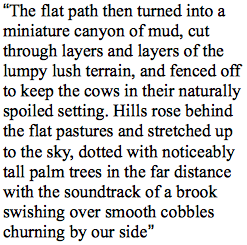 We came to hike up into the hills of the Cocora Valley, as most Colombians and travelers do. After getting our gear into our bunks we set back off for Salento, walking back to the central plaza. Once enough travelers were rounded up to fill our 4×4 we set off. Our group consisted of a German girl traveling by herself and 6 Americans. We rode up into the hilly terrain for about 30 minutes or so until we came to the end of the road. The trail head was a footpath that lead into a field a few hundred yards from where we were dropped off. The flat path then turned into a miniature canyon of mud, cut through layers and layers of the lumpy lush terrain, and fenced off to keep the cows in their surreal pastures. Hills rose behind the flat pastures and stretched up to the sky, dotted with noticeably tall palm trees in the far distance with the soundtrack of a brook swishing over smooth cobbles churning by our side. Handmade bridges appeared over areas where the stream was too deep to cross safely on foot. We entered into a jungle-like forest and came across swing bridges, like the kind you might find in an Indiana Jones flick. Huge, leafy plants, moss covered trees, and crystal clear waters set the pace for the scene. We crossed each bridge 1 x 1, with each step giving a gentle swing to the entire structure. As we hiked further into the forest it became very apparent that it was going to rain really, really hard. Drops started falling out of the sky one by one until I damned my existence without my trusty poncho. For some reason beyond my wildest imagination I came unprepared for rain, which is a consideration that is usually at the forefront of my planning. Shortly after the rain started we came to the fork in the path that would lead us to shelter and the rumors of Colombian mountain snacks. A family lived way up in those hills, so far away from anyone else, and the only forms transportation to and from town was foot or horseback. As promised, they took us in from the rain and fed us hot chocolate with cheese while the rain mockingly applauded all our efforts to spend the day outdoors. We passed the time watching the broad assortment of wild hummingbirds that lived within the forest surrounding the house. They ranged from tiny to sparrow sized statures and some had tails almost a foot long. Domesticated by human presence, they allowed us to get in really close and snap a few portraits before we eventually left. A group vote decided that the rain wasn’t letting up, and we had to press on.
We came to hike up into the hills of the Cocora Valley, as most Colombians and travelers do. After getting our gear into our bunks we set back off for Salento, walking back to the central plaza. Once enough travelers were rounded up to fill our 4×4 we set off. Our group consisted of a German girl traveling by herself and 6 Americans. We rode up into the hilly terrain for about 30 minutes or so until we came to the end of the road. The trail head was a footpath that lead into a field a few hundred yards from where we were dropped off. The flat path then turned into a miniature canyon of mud, cut through layers and layers of the lumpy lush terrain, and fenced off to keep the cows in their surreal pastures. Hills rose behind the flat pastures and stretched up to the sky, dotted with noticeably tall palm trees in the far distance with the soundtrack of a brook swishing over smooth cobbles churning by our side. Handmade bridges appeared over areas where the stream was too deep to cross safely on foot. We entered into a jungle-like forest and came across swing bridges, like the kind you might find in an Indiana Jones flick. Huge, leafy plants, moss covered trees, and crystal clear waters set the pace for the scene. We crossed each bridge 1 x 1, with each step giving a gentle swing to the entire structure. As we hiked further into the forest it became very apparent that it was going to rain really, really hard. Drops started falling out of the sky one by one until I damned my existence without my trusty poncho. For some reason beyond my wildest imagination I came unprepared for rain, which is a consideration that is usually at the forefront of my planning. Shortly after the rain started we came to the fork in the path that would lead us to shelter and the rumors of Colombian mountain snacks. A family lived way up in those hills, so far away from anyone else, and the only forms transportation to and from town was foot or horseback. As promised, they took us in from the rain and fed us hot chocolate with cheese while the rain mockingly applauded all our efforts to spend the day outdoors. We passed the time watching the broad assortment of wild hummingbirds that lived within the forest surrounding the house. They ranged from tiny to sparrow sized statures and some had tails almost a foot long. Domesticated by human presence, they allowed us to get in really close and snap a few portraits before we eventually left. A group vote decided that the rain wasn’t letting up, and we had to press on.
 We hiked up and up on a path through the woods. Dense fog crept in while the rain progressively thinned out to fat drops every second or two. The tall, solid pines stretched into the hazy abyss just below their tallest branches. The forest stopped at the foot of a terraced hill with a small house on top. It turned out to be the highest elevation point of our hike, and was prepared for weary hikers by providing long benches to rest on and take in the view. The clouds were chasing each other vertically up from the valley and began to dissolve in front of our eyes. Tree tops started appearing as the filtered light began to grow in it’s intensity. Everyone took of their rain coats and relished in the warm air. We were walking downhill now, and the fenced off field to our left started clearing up to show us the magical views below. A stunning valley cut through the land, with us standing near the top of it looking down and around at nothing but pure forests and farmland. Ominous dark clouds at the bottom of the valley added even more character to the hillsides plastered with gigantic, 150 foot tall wax palm trees. They stuck out of the landscape like magnified toothpicks topped with umbrellas, grouped in clusters along ridges, hanging over the tree tops of the forests, and also alone in the lower hills. It felt like we had the world to ourselves, enjoying the nurturing air and fresh foreign views without a soul in sight. There was no promise that we would even see a car coming up this road, which is a beautiful thought to let linger in your mind. Cows and horses seemed to be on their own out here, grazing alongside the palms, with foggy mountains rising behind them. We couldn’t wait to get up close and personal with the trees, and put ourselves into the lucid scene that seemed to be just out of reach. As we walked further down into the valley we eventually found a place where we could get right underneath them to size them up from a personal perspective. It was one of the most vivid moments of my life, walking around the valley that day. Every step in this weird world was rewarding and every breath of air felt clean and pure. We snapped quite a few images of this unique setting before making our way back to hire a jeep to town.
We hiked up and up on a path through the woods. Dense fog crept in while the rain progressively thinned out to fat drops every second or two. The tall, solid pines stretched into the hazy abyss just below their tallest branches. The forest stopped at the foot of a terraced hill with a small house on top. It turned out to be the highest elevation point of our hike, and was prepared for weary hikers by providing long benches to rest on and take in the view. The clouds were chasing each other vertically up from the valley and began to dissolve in front of our eyes. Tree tops started appearing as the filtered light began to grow in it’s intensity. Everyone took of their rain coats and relished in the warm air. We were walking downhill now, and the fenced off field to our left started clearing up to show us the magical views below. A stunning valley cut through the land, with us standing near the top of it looking down and around at nothing but pure forests and farmland. Ominous dark clouds at the bottom of the valley added even more character to the hillsides plastered with gigantic, 150 foot tall wax palm trees. They stuck out of the landscape like magnified toothpicks topped with umbrellas, grouped in clusters along ridges, hanging over the tree tops of the forests, and also alone in the lower hills. It felt like we had the world to ourselves, enjoying the nurturing air and fresh foreign views without a soul in sight. There was no promise that we would even see a car coming up this road, which is a beautiful thought to let linger in your mind. Cows and horses seemed to be on their own out here, grazing alongside the palms, with foggy mountains rising behind them. We couldn’t wait to get up close and personal with the trees, and put ourselves into the lucid scene that seemed to be just out of reach. As we walked further down into the valley we eventually found a place where we could get right underneath them to size them up from a personal perspective. It was one of the most vivid moments of my life, walking around the valley that day. Every step in this weird world was rewarding and every breath of air felt clean and pure. We snapped quite a few images of this unique setting before making our way back to hire a jeep to town.
The farm at La Serrana offered gorgeous mountain views that were best enjoyed sipping freshly brewed Colombian coffee and munching on delicious local fruits the land gives it’s lucky visitors. We heard from other travelers who visited the area that a visit to an organic coffee farm named Sachamama was an absolute must . To get to Sachamama we had to memorize vague instructions involving holes in fences, landmarks, paths, bridges, and horse roads. We left with a small group of some other tourists that wanted to check out the farm and began walking down the gravel road away from town. We cut through terraced farm lands, down steep hills, past the occasional house, and into a pristine, almost silent valley with green forests on either side of the blue stream cutting through the middle. Fresh fruit fell from trees along the way, which I never pass up, and sweetened the path to the farm.
Buried deep off the beaten path (literally off beaten paths), Sachamama is a family run eco-farm that is nurtured by a biologist turned conservationist named Pedro. He, along with his wife Maryori and their two children, planted themselves here within the jungle like terrain of natural hills, rivers, and forests with the idea that coffee and other plants grow in harmony with each other instead of the commercial crop farming method. Pedro welcomed us with a hearty smile and immediately brought us upstairs to enjoy the view from his family’s den overlooking the land while the daily morning rainfall diminished. He was expecting a few more travelers who showed up shortly thereafter. He explained his idea and the purpose of the farm, along with the importance of coffee and how it’s grown. Fresh cups of the freshest form were given to every soul that wanted one. It was hard to pay attention to his story with each sip of the most delicious coffee I’ve ever had. The deliciously soothing cup of Joe needed absolutely nothing to enhance the flavor and felt completely natural at it’s core. After the intro and story, Pedro took us outside for a walk through his creation. Instead of sectioning off areas for specific plants, Pedro advocates letting the forest live in harmony with itself. He pointed out the benefits each plant has with each other, which is the basic idea behind permaculture. Each plant adds their own nutrients to the soil while they feed on other nutrients present from the plant and animal live that interacts with it. Pedro’s coffee plants were nearly 30 years in age, which is part of the secret of his flavorful roast. He claimed that coffee plants that are allowed to mature to an age like this will produce a better quality fruit. He explained that the average lifespan of commercially farmed coffee plants hover around the 5 year mark until their yield doesn’t match the farm’s needs and the fields need to be replanted. He let us hand harvest the coffee fruit, as he and his family does daily, and demonstrated how they extract the bean using a hand cranked press. Beans are then set out to dry in a large box for a few weeks prior to roasting. Pedro’s roasting production shack was a 10 minute walk up the road on the top of a hill overlooking more pristine farmland. He brought some beans that were ready to be roasted and let us into his little factory for a finished product demonstration. We fired up two little roasters fed by a small camping propane tank and coals. After coals were hot enough we measured out beans and put them in the oven, hand cranking the tumbler to get an even roast. The aroma coming from these little ovens was unreal. After the beans were roasted to perfection we bagged them up and sealed them in his own branded bags. We were educated from start to finish on the coffee roasting process in the most natural setting, which is a perfect memory to keep.
 Salento offers a great community of activities on the weekend for locals and travelers alike. The town comes to life on Fridays and Saturdays, with live music, tons of restaurants offering local treats like fresh ice cream, trout on top of a huge pancake shaped deep fried plantain, and of course Aguila cervezas within spitting distance anywhere you looked. A peek through the swinging doors of one of the many saloons would grace your curiosity with Colombian cowboys shooting pool or playing cards. We also played Tejo for the first time in Salento, which is Colombians’ treasured game of throwing weighted disks at packages of gunpowder (think horse shoes with explosions). It was a shockingly natural game for me because my first time playing I made 4 hits, each of which scared the hell out of me. The explosions, which resembled the sound of the starting pistol at a race, would thrust small pieces of non-threatening shrapnel that could hit both your opponents and yourself in the face. Good times, good times.
Salento offers a great community of activities on the weekend for locals and travelers alike. The town comes to life on Fridays and Saturdays, with live music, tons of restaurants offering local treats like fresh ice cream, trout on top of a huge pancake shaped deep fried plantain, and of course Aguila cervezas within spitting distance anywhere you looked. A peek through the swinging doors of one of the many saloons would grace your curiosity with Colombian cowboys shooting pool or playing cards. We also played Tejo for the first time in Salento, which is Colombians’ treasured game of throwing weighted disks at packages of gunpowder (think horse shoes with explosions). It was a shockingly natural game for me because my first time playing I made 4 hits, each of which scared the hell out of me. The explosions, which resembled the sound of the starting pistol at a race, would thrust small pieces of non-threatening shrapnel that could hit both your opponents and yourself in the face. Good times, good times.
Traveling thrives on moments like these, feeding that inner soul of ours with the positive reinforcement that you are doing exactly what you should be doing in life at that moment. That feeling only comes around when you discover something for the very first time, and is impossible to recreate on your own devices. These experiences are those that we get to hang onto forever, which is something worth more than it’s weight in gold but can not actually be purchased with it.
Weekly Photo Challege: Horizon
This weekly challenge is on an aspect of photography that is very near and dear to me. Horizon lines are something that I find myself focusing on with without even fully processing thoughts of why I’m drawn to produce the image I am creating in the first place. They fascinate me. I love observing landscapes and the scene that unfolds within them. Landscapes are often canvases that you leave untouched, unspoiled, and undisturbed when you line up your shot. This allows the vision of what is in front of your eyes tell the storyline, perform the silent dialogue, and provoke the feelings out of your soul and into your heart. They can begin at the tips of your toes and follow a long, winding path miles from your vantage point. Horizons provoke an insatiable desire within myself to follow them until they blend in with the edge of the world; down the slopes of a mountain, along the tops of breaking ocean waves, along the frame of barns of a farm on the crest of a hill, across tops of endless dunes in the desert, and endless flat snowy fields of my hometown in Upstate New York. Horizon lines play a great role in how I frame my images, and how my mind chooses to view the world.
This week’s challenge brings me to share an image that will be featured in an upcoming post about my travels through the mountains of the lush valley of Corcora in Colombia. The horizon is comprised of several different layers with different focal points, which gives the image a sense of still motion. I love observing the lines from the hill in the foreground on the farm where I stood to capture the image, and the rolling mountains catching the last rays of the sunset coated with small pockets of fog rising in the valleys. There are several horizon lines crossing each other at different dips and angles, and all of them seem to disappear in the world in their own style. I hope you all enjoy this image as much as I liked taking it.
-
Join 15.5K other subscribers

Come away with me
Top Posts & Pages
Blog Stats
- 213,064 hits
Penny Karma
The run down
Blogroll













